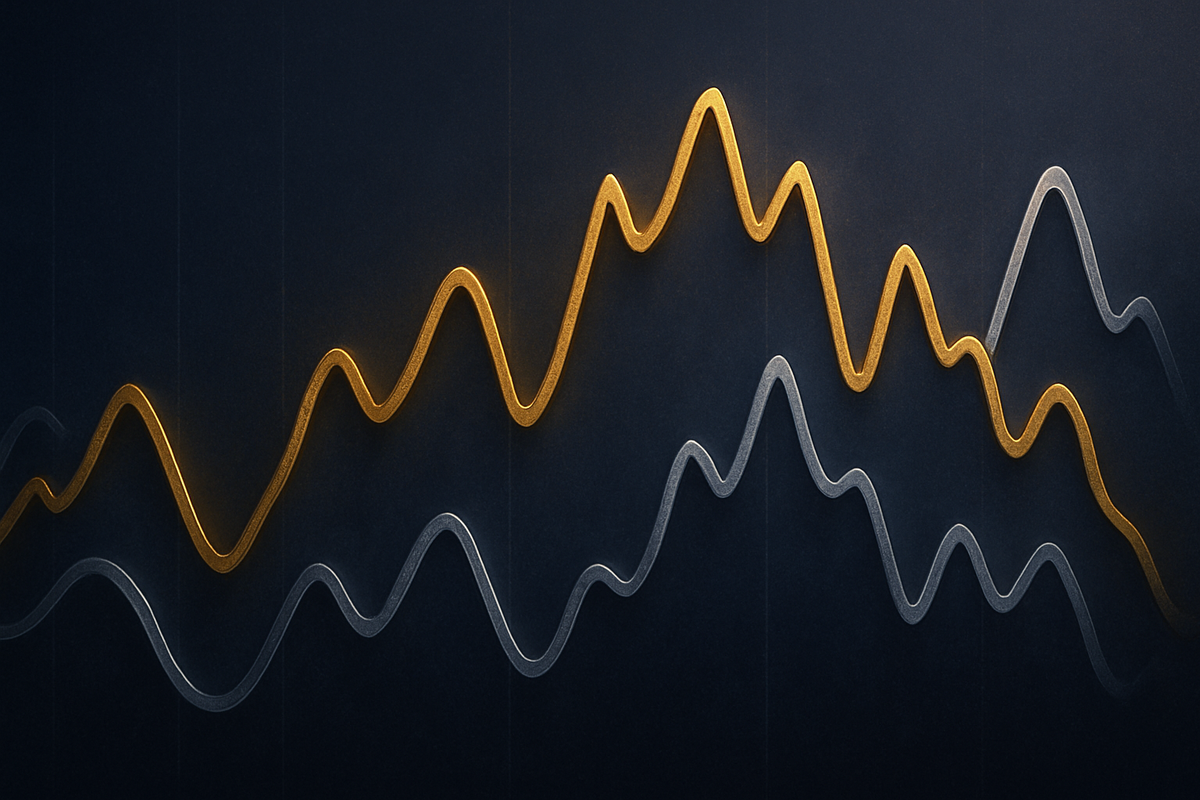
The precious metals market is experiencing a significant surge in volatility, as gold and silver, fresh off unprecedented rallies, face a wave of profit-taking. On October 17, 2025, both metals, after touching new multi-year and all-time highs, witnessed sharp intraday declines, signaling a potential short-term correction in an otherwise robust bull market. This abrupt shift is prompting investors to re-evaluate positions and consider the immediate implications for market stability and future price trajectories.
This recent episode highlights the inherent dynamics of commodity markets, where rapid ascent often precedes periods of consolidation or pullback. While the underlying bullish fundamentals for gold and silver remain largely intact, the current profit-taking spree underscores the increased risk of volatility and the necessity for a disciplined investment approach in these high-flying assets.
Record Rallies Meet Sharp Corrections
The journey to these recent highs has been nothing short of spectacular for both gold and silver. Gold's ascent has been particularly striking, with prices soaring over 50% in 2025 alone. On October 7, 2025, gold broke above $4,000 per ounce for the first time, reaching $4,031.54. This rally culminated on October 17, 2025, when spot gold (XAU) touched an unprecedented all-time peak of approximately $4,378.69 to $4,379 per ounce, with U.S. gold futures for December delivery reaching a record $4,391.69 per ounce. This historic run put gold on track for its strongest weekly gain since December 2008.
Silver's performance has been equally impressive, surging over 50% in the first nine months of 2025 and reaching a 14-year high above US$44 on September 22. Since the start of 2025, silver prices have surged by a massive 78.73%, recently closing above $50 per ounce – a price point not seen in over four decades. On October 17, 2025, silver hit a multi-year high of $54.49 and an all-time intraday high of $54.47 per ounce.
However, the euphoria of these record highs was quickly tempered by significant profit-taking. On October 17, 2025, after hitting its record high, spot gold retreated by 2.00% to settle at $4,236.57 from its intraday peak, slipping below $4,300. Silver also experienced a dramatic fluctuation on the same day, falling 1.7% to $53.32 after its record high. Earlier in the week, on October 14, 2025, silver had already seen a pullback to $51.64, a 1.31% decline from the previous day, consolidating around $52.40 after retreating from a peak of $53.77. These sharp intraday reversals are indicative of technical corrections, with some analysts warning of "blow-off top" signals for gold and overbought conditions for silver, suggesting a potential for multi-month consolidation or a significant pullback.
The key players in this scenario include large institutional investors, hedge funds, and retail traders who have been riding the bullish wave. Central banks, particularly those in emerging economies, have also been significant buyers of gold, contributing to the sustained demand. The initial market reaction to the pullbacks has been a mix of caution and opportunism, with some investors seeing these dips as healthy corrections and potential entry points, while others are bracing for further volatility. The swiftness of the decline, even from record highs, underscores the sensitivity of these markets to profit-taking pressures.
Public Companies in the Crosshairs of Metal Volatility
The recent volatility in gold and silver prices has significant implications for public companies across various sectors, particularly those involved in mining, precious metals trading, and industrial applications of silver. The rapid appreciation followed by sharp pullbacks creates both opportunities and risks for these entities.
Potential Winners: Mining companies with strong operational efficiency and low production costs are best positioned to benefit from sustained high precious metal prices, even with short-term volatility. Companies like Barrick Gold Corp. (NYSE: GOLD) and Newmont Corporation (NYSE: NEM) are major gold producers whose revenues and profitability are directly tied to gold prices. While a dip in prices might temporarily impact their stock performance, a long-term bullish trend in gold provides a strong tailwind for their earnings. Similarly, silver miners such as Pan American Silver Corp. (NASDAQ: PAAS) and Hecla Mining Company (NYSE: HL) stand to gain substantially from elevated silver prices, especially given silver's dual role as a precious and industrial metal. For these companies, a healthy pullback could be seen as a market re-calibration rather than a fundamental threat, potentially allowing them to lock in higher prices for their output.
Potential Losers: Companies with high debt loads or inefficient operations might find themselves more vulnerable during periods of increased volatility and profit-taking. A sustained decline, even if it's a correction, could squeeze their profit margins and make debt servicing more challenging. Furthermore, companies that have hedged their production at lower prices might miss out on the full benefit of the recent rallies. On the demand side, industries heavily reliant on silver as an industrial input, such as electronics manufacturers and solar panel producers, might face increased raw material costs. While these costs can often be passed on to consumers, sudden and sharp price increases in silver could impact their profitability or force them to seek alternative materials, though silver's unique properties often make substitution difficult. Companies like First Solar, Inc. (NASDAQ: FSLR), a leading solar panel manufacturer, could experience pressure on their input costs if silver's industrial demand-driven price surge continues without significant pullbacks.
The impact on these companies' stock performance will likely mirror the sentiment in the broader precious metals market. During rallies, their stocks tend to outperform, while pullbacks often lead to corresponding dips. Investors will be closely watching these companies' quarterly reports for updates on production costs, hedging strategies, and their ability to navigate price fluctuations, especially given the current backdrop of heightened market sensitivity.
Broader Significance and Market Trends
The recent profit-taking and volatility in gold and silver prices are not isolated incidents but rather fit into several broader industry trends and economic narratives. This event underscores the ongoing shift in global financial markets towards tangible assets amidst persistent economic uncertainties and geopolitical tensions.
Firstly, the robust rallies leading up to the current volatility highlight the enduring appeal of precious metals as a hedge against inflation and currency debasement. With global central banks, including the Federal Reserve, grappling with inflation and the prospect of future interest rate adjustments, investors are increasingly seeking safe havens. The expectation of Federal Reserve interest rate cuts, even if delayed, has been a significant bullish factor for gold, as lower rates reduce the opportunity cost of holding non-yielding assets. Geopolitical instability, ranging from regional conflicts to global trade disputes, further fuels demand for gold as a traditional safe-haven asset.
Secondly, silver's exceptional performance is indicative of its dual role. Beyond its status as a precious metal, silver is a critical industrial commodity. The accelerating demand from the electronics, solar energy, and electric vehicle sectors is a powerful structural driver for silver prices. This industrial demand provides a floor for silver prices and often amplifies its movements during broader commodity rallies. The recent volatility, while a short-term correction, does not diminish the long-term outlook driven by the green energy transition and technological advancements.
Historically, periods of rapid price appreciation in commodities are often followed by corrections as market participants lock in profits. The current scenario for gold and silver can be compared to previous commodity supercycles, where sharp rallies were interspersed with significant pullbacks. For instance, the commodity boom of the early 2000s saw similar patterns in various raw materials. These corrections are often viewed as healthy, preventing the formation of unsustainable bubbles and allowing for price discovery at more realistic levels.
Regulatory or policy implications are less direct in the immediate term, but sustained high prices or extreme volatility could draw increased scrutiny from financial regulators regarding market manipulation or excessive speculation. Central banks' continued accumulation of gold also signals a broader policy shift towards diversifying reserves away from traditional fiat currencies, a trend that could have long-term implications for the global financial architecture. The Gold/Silver ratio, which has climbed to over 80, suggests gold is currently outperforming silver. Historically, such a high ratio often indicates silver is undervalued in the long term, hinting at potential future outperformance relative to gold. This ratio is a key metric that market participants will continue to monitor for insights into relative value.
What Comes Next for Precious Metals
The immediate future for gold and silver is likely to be characterized by continued volatility, as the market digests the recent gains and subsequent profit-taking. In the short term, investors should brace for further price swings. The "blow-off top" warnings for gold and overbought conditions for silver suggest that a healthy pullback or a period of consolidation, possibly towards the $3,500 level for gold, could be on the horizon. These corrections, while unsettling, are often seen as necessary to reset the market and create new entry points for long-term investors. Traders will be closely watching technical support and resistance levels, as well as macroeconomic data, particularly inflation reports and central bank commentary on interest rates.
Looking at the long term, the fundamental drivers for precious metals remain robust. Geopolitical instability, persistent inflation, and the ongoing demand from central banks for gold accumulation are powerful tailwinds that are unlikely to dissipate soon. For silver, the accelerating industrial demand from the green energy transition (solar panels, EVs) and electronics sectors provides a strong structural bull case. This suggests that while short-term corrections are probable, the overarching trend for both metals is likely to remain upward.
Potential strategic pivots for investors might involve rebalancing portfolios to account for the increased volatility, perhaps taking some profits from recent gains while maintaining core positions for long-term appreciation. Adaptations required could include a more disciplined approach to risk management, with tighter stop-losses and careful position sizing. Market opportunities may emerge during significant dips, offering attractive entry points for those who missed the initial rallies or wish to increase their exposure. Conversely, challenges will include navigating the psychological impact of sharp pullbacks and distinguishing between healthy corrections and genuine trend reversals.
Potential scenarios and outcomes include:
- Scenario 1: Healthy Correction and Resumption of Rally: Prices consolidate for a few weeks or months, potentially dropping by 10-15%, before resuming their upward trajectory driven by persistent inflation and safe-haven demand.
- Scenario 2: Extended Consolidation: The market enters a longer period of range-bound trading as it searches for a new equilibrium, with prices fluctuating within a wider band.
- Scenario 3: Deeper Pullback (Less Likely for Long-Term): A more significant economic shift, such as a rapid resolution of geopolitical tensions or a decisive victory over inflation, could lead to a more substantial correction, though the current macroeconomic environment makes this less probable for a sustained period.
Navigating the Golden and Silver Tides Ahead
The recent profit-taking and increased volatility in gold and silver prices mark a critical juncture for the precious metals market. The key takeaway from this event is that while the bullish narrative for both metals remains incredibly strong, driven by inflation concerns, geopolitical risks, and robust industrial demand for silver, the path forward will not be a straight line. Investors must acknowledge and prepare for periods of significant price swings, even as new record highs are being forged.
Moving forward, the market will be keenly assessing several factors. The pace and extent of future central bank interest rate decisions, particularly by the Federal Reserve, will heavily influence gold's appeal. Any signs of persistent inflation will continue to bolster demand for precious metals as an inflation hedge. Geopolitical developments will also play a crucial role, with escalating tensions typically providing a boost to safe-haven assets. For silver, the growth trajectory of the green energy sector and technological advancements will be paramount, as these sectors represent a significant and growing source of industrial demand.
Investors should watch for sustained price action above or below key technical levels, as these will signal the market's conviction. Monitoring the Gold/Silver ratio will also offer insights into the relative strength and potential future outperformance of one metal over the other. Furthermore, keeping an eye on the supply-demand dynamics from major mining companies and central bank buying patterns will provide a comprehensive view of the market's health.
In conclusion, while the recent pullbacks may induce short-term anxiety, they are likely a healthy recalibration within a larger, structurally bullish environment for gold and silver. The long-term significance of this period will be defined by how these metals continue to serve as vital components in diversified portfolios, offering both inflation protection and growth potential in an uncertain global economy. Disciplined investing, informed by thorough research and a long-term perspective, will be crucial for navigating the golden and silver tides in the months to come.
This content is intended for informational purposes only and is not financial advice







